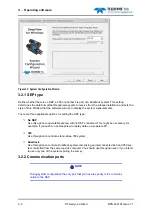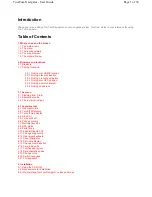
2 – Installation
2-10
© Teledyne Limited
DPN 402197 Issue 7.1
2.2.3 Altimeter Installation
When you use an altimeter with the 350 system, install it according to the following guidelines:
❐
Install the altimeter as close as possible to the centre of the coil array in the lateral and fore-aft
directions.
❐
Make certain the altimeter has a clear vertical view to the seabed across its entire beam width.
❐
When you select a position for the altimeter, make allowance for its
minimum
measurement
range capability.
❐
Measure and record any vertical offset between the transducer face of the altimeter and the
reference line of the coil array (as defined in
). You will use this information to config-
ure the display software.
❐
Secure the altimeter to the ROV frame in such a way that it does not move or vibrate inde-
pendently.
Errors can arise in the measurement of depth of cover caused by horizontal offset between the
altimeter and the centre of the coil array. In the example shown in
there are altimeters
located at ‘A’ and ‘B’. Because of the seabed topography beneath the ROV, both altimeters supply
different measurements of altitude. Note that, although the measurements of target position supplied
by the 350 System remain accurate, errors in depth of cover measurements will vary according to the
altimeter position and the seabed topography.
Figure 2-7: Effects of altimeter horizontal offset
IMPORTANT
The altimeter provides information valid only for a point directly below its trans-
ducer face but parallel to its axis. When you operate the ROV over uneven sea-
bed, or where the target is in a trench, it is strongly recommended that you use a
separate profiling system to measure the seabed level.
With the altimeter mounted correctly, the 350 system will provide additional information and features:
❐
It will supply accurate depth of cover measurements with the target centred under the coils.
















































